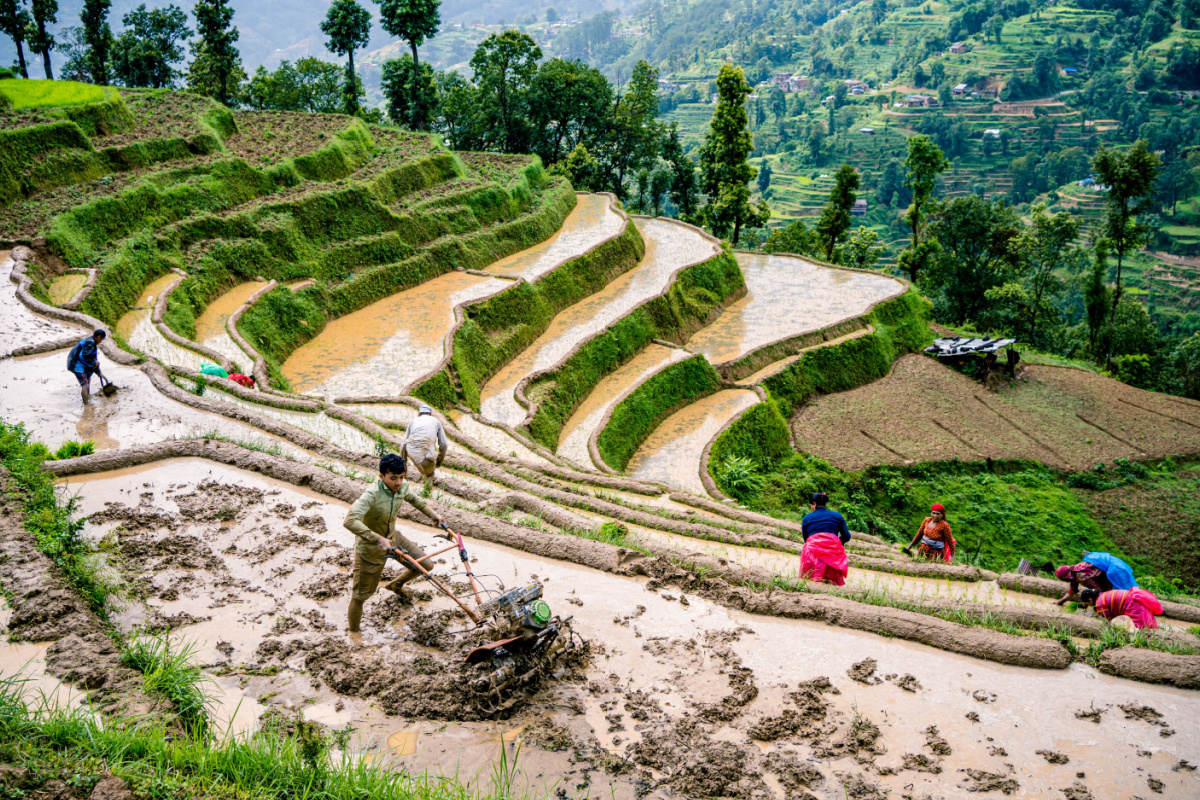Opinion | Land equity for food security
Land equity for food security The Kathmandu Post


Nepal’s Food Security Crisis: The Role of Land in Achieving Sustainable Development Goals

Introduction
Nepal confronts a moderate level of hunger, ranking 81st out of 121 qualifying countries with a score of 19.1 on the Global Hunger Index. However, the country’s growing dependency on food imports paints a bleak picture of its food security situation. From mid-July 2022 to mid-May 2023, Nepal imported agricultural and commodity goods worth Rs250 billion from 184 countries. Unfortunately, the intervention to improve food security from the government and non-government sectors is more technical than structural, which fails to identify and address the causes that have gradually led the country to severe food insecurity. The land question is often overlooked, but it must be understood and addressed to effectively tackle food insecurity.
The Impact of Land on Food Security
In the last week of July this year, I participated in a discussion on agricultural issues in Gadawa, Dang. Srijana Chaudhary, who farmed vegetables on rented land, informed us that she had to abandon farming because the landowner terminated her contract. The landowner wanted to rent the land to a company from Chitwan that was searching for land for large-scale banana farming. The landowner took Chaudhary’s rented-in land back as the company offered a higher rent. This severely impacted Chaudhary and her neighbours’ food security and livelihoods, leaving her unable to financially support herself to seek treatment despite having serious health issues.
This case highlights the strong connection between food security, agriculture, and land. It is easy to foresee the increasingly severe crisis that Nepal’s agriculture and food security sector will face in the near future. One of the preventive measures is establishing a comprehensively addressed land-related issue, but both the government and the organizations investing in the agricultural sector have ignored this.
During the same week, the UN Food Systems Stocktaking Moment was convened in Rome, Italy, emphasizing the significant contribution of small-scale farmers to global food systems and offering solutions to sustainability challenges. However, the delegates didn’t discuss the issue of land distribution and the conversion of agricultural land for other purposes besides food production. Prime Minister Pushpa Kamal Dahal participated in the event but failed to address the fundamental questions concerning the food security of marginalized communities.
The Importance of Land Tenure Security
Land tenure security of the actual tillers plays a significant role in ensuring food sovereignty in Nepal. The Land Reform Act of 1964 recognized the tenancy system, allowing tenants long-term land access. However, the tenancy provisions were abolished in 1997, aiming to end dual ownership between landowners and tenants. This was a crucial rage for tenancy reform as the land separation between the landowners and the tenants had not been completed. Furthermore, the incompleteness of the reform discouraged the landowner and tenant from investing in agriculture.
Another common tenure practice in Nepal is sharecropping, in which the landowner allots land use to sharecroppers for a specific number of years. The landowner’s ability to terminate the arrangement at any time, as it lacks a written deal, is the major drawback of this arrangement. Hence, sharecropping cultivators are discouraged, leading to a growing area of cultivable land going fallow, with an apparent negative consequence for the country’s food security.
With ongoing unplanned urbanization and the absence of rigorous land use planning, converting agricultural land for non-agricultural purposes is widespread. In Nepal, the constitutional rights over ancestral private land also accelerate land degradation as families divide their land among family members, increasing fragmentation and resulting in land conversion for commercial purposes and inappropriate land use.
Land inequality is the oldest and most fundamental type of wealth inequality. The wealthiest 7 percent of households own around 31 percent of agricultural land. Half of Nepali farmers own less than 0.5 hectares of land. An estimated 1.3 million families are landless and in informal shelters in the country. Without addressing this unequal land distribution, the food sovereignty goals of the country would be hard to meet.
Protecting Fertile Land for Food Security
The Right to Food and Food Sovereignty Act, 2018, has been enacted and brought into force. This is a welcoming step. It seeks to bridge the gap regarding the “right” and “access” to food and its security. However, the rights of the peasants and landless people, as well as the considerable stress on the equitable development of agriculture, are inadequately included in the food sovereignty framework. The law does not fully come into force without food rights and sovereignty policies. Sadly, five years have passed since the enactment of the law, and the Ministry of Agriculture and Livestock has failed to establish the necessary rules.
Meanwhile, the government recently lifted the restrictions imposed on land plotting in the name of revitalizing the country’s economy, raising serious concerns regarding agricultural land protection from the perspective of food sovereignty.
Access to land plays a central role in ensuring food sovereignty in Nepal. In the given diverse geo-ecological regions and agricultural practices, equitable and appropriate land distribution supports local food production, reduces dependency on external sources, and fosters self-reliance, eventually enhancing the country’s food security.
Land, agriculture, and food security cannot be strengthened solely through central planning and efforts. This has already proven unsuccessful. A comprehensive analysis of land, agriculture, and food security at the community and local levels with meaningful participation of the landless and peasants is required. The authorities should properly address the issue of access to land. The concrete effort should be targeted to enhance family farming and protect the landless and small-scale farmers. Food insecurity will continue to rise at an accelerated rate if the government fails to protect agricultural land, smallholders, and peasants, particularly from profit-making agricultural companies.
SDGs, Targets, and Indicators
| SDGs | Targets | Indicators |
|---|---|---|
| SDG 2: Zero Hunger | 2.1: By 2030, end hunger and ensure access by all people, in particular the poor and people in vulnerable situations, including infants, to safe, nutritious and sufficient food all year round | – Global Hunger Index (GHI) score |
| SDG 2: Zero Hunger | 2.3: By 2030, double the agricultural productivity and incomes of small-scale food producers, in particular women, indigenous peoples, family farmers, pastoralists and fishers, including through secure and equal access to land, other productive resources and inputs, knowledge, financial services, markets and opportunities for value addition and non-farm employment | – Land tenure security for small-scale food producers – Land distribution and conversion for non-agricultural purposes |
| SDG 10: Reduced Inequalities | 10.2: By 2030, empower and promote the social, economic and political inclusion of all, irrespective of age, sex, disability, race, ethnicity, origin, religion or economic or other status | – Land inequality (wealthiest households owning agricultural land) – Landless families and informal shelters |
1. Which SDGs are addressed or connected to the issues highlighted in the article?
SDG 2: Zero Hunger
The article discusses Nepal’s food security situation and the connection between land, agriculture, and food security. SDG 2 aims to end hunger, achieve food security, improve nutrition, and promote sustainable agriculture.
SDG 10: Reduced Inequalities
The article highlights land inequality in Nepal, with a small percentage of households owning a significant portion of agricultural land. SDG 10 focuses on reducing inequalities within and among countries.
2. What specific targets under those SDGs can be identified based on the article’s content?
Target 2.1: By 2030, end hunger and ensure access by all people, in particular the poor and people in vulnerable situations, including infants, to safe, nutritious and sufficient food all year round.
The article mentions Nepal’s ranking on the Global Hunger Index (GHI) and its score of 19.1. This indicates the level of hunger in the country and the need to ensure access to safe and nutritious food for all.
Target 2.3: By 2030, double the agricultural productivity and incomes of small-scale food producers, in particular women, indigenous peoples, family farmers, pastoralists and fishers, including through secure and equal access to land, other productive resources and inputs, knowledge, financial services, markets and opportunities for value addition and non-farm employment.
The article discusses the impact of land distribution and conversion for non-agricultural purposes on small-scale farmers’ livelihoods and food security. Ensuring secure and equal access to land is crucial for improving agricultural productivity and incomes.
Target 10.2: By 2030, empower and promote the social, economic and political inclusion of all, irrespective of age, sex, disability, race, ethnicity, origin, religion or economic or other status.
The article highlights land inequality in Nepal, with a small percentage of households owning a significant portion of agricultural land. Target 10.2 aims to promote social and economic inclusion, reducing inequalities based on various factors, including land ownership.
3. Are there any indicators mentioned or implied in the article that can be used to measure progress towards the identified targets?
The article mentions specific indicators that can be used to measure progress towards the identified targets:
– Global Hunger Index (GHI) score: This indicator measures the level of hunger in a country. The article states that Nepal has a score of 19.1 on the GHI, highlighting the need to address food security issues.
– Land tenure security for small-scale food producers: The article discusses the importance of secure access to land for small-scale farmers. Ensuring land tenure security can contribute to achieving Target 2.3.
– Land distribution and conversion for non-agricultural purposes: The article highlights the negative consequences of land distribution and conversion for non-agricultural purposes on food security. Monitoring and addressing these issues can help track progress towards Target 2.3.
– Land inequality (wealthiest households owning agricultural land): The article mentions that the wealthiest 7 percent of households in Nepal own around 31 percent of agricultural land. This indicator reflects the level of land inequality and can be used to assess progress towards Target 10.2.
– Landless families and informal shelters: The article states that an estimated 1.3 million families in Nepal are landless and live in informal shelters. Monitoring the number of landless families can help measure progress towards Target 10.2.
4. SDGs, Targets, and Indicators Table
| SDGs | Targets | Indicators |
|---|---|---|
| SDG 2: Zero Hunger | 2.1: By 2030, end hunger and ensure access by all people, in particular the poor and people in vulnerable situations, including infants, to safe, nutritious and sufficient food all year round | – Global Hunger Index (GHI) score |
| SDG 2: Zero Hunger | 2.3: By 2030, double the agricultural productivity and incomes of small-scale food producers, in particular women, indigenous peoples, family farmers, pastoralists and fishers, including through secure and equal access to land, other productive resources and inputs, knowledge, financial services, markets and opportunities for value addition and non-farm employment | – Land tenure security for small-scale food producers – Land distribution and conversion for non-agricultural purposes |
| SDG 10: Reduced Inequalities | 10.2: By 2030, empower and promote the social, economic and political inclusion of all, irrespective of age, sex, disability, race, ethnicity, origin, religion or economic or other status | – Land inequality (wealthiest households owning agricultural land) – Landless families and informal shelters |
Behold! This splendid article springs forth from the wellspring of knowledge, shaped by a wondrous proprietary AI technology that delved into a vast ocean of data, illuminating the path towards the Sustainable Development Goals. Remember that all rights are reserved by SDG Investors LLC, empowering us to champion progress together.
Source: kathmandupost.com

Join us, as fellow seekers of change, on a transformative journey at https://sdgtalks.ai/welcome, where you can become a member and actively contribute to shaping a brighter future.







